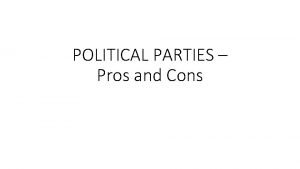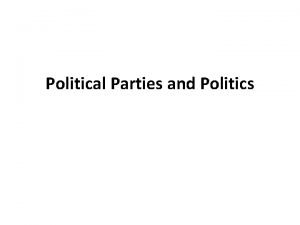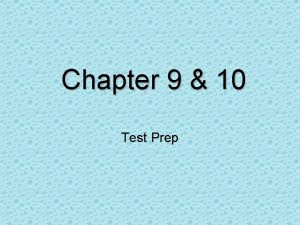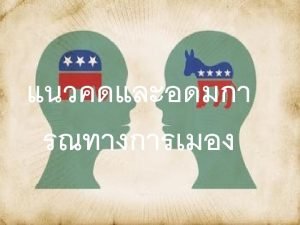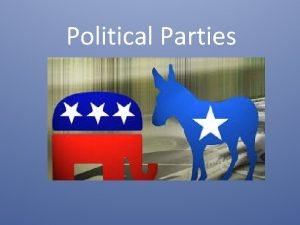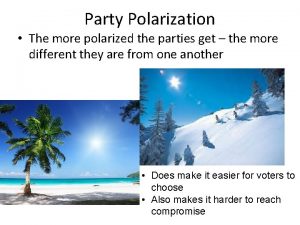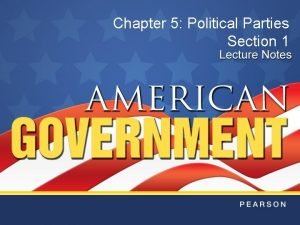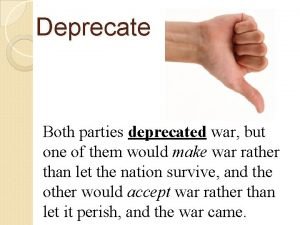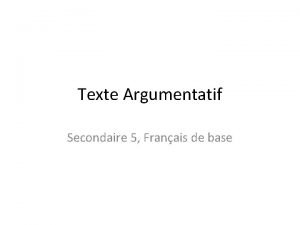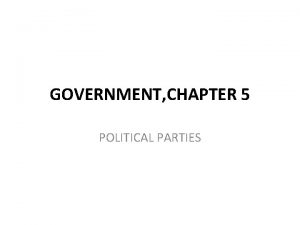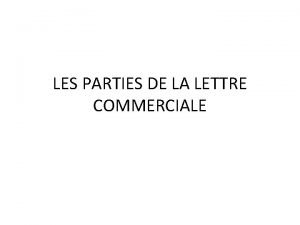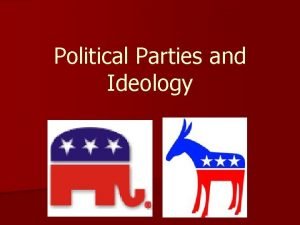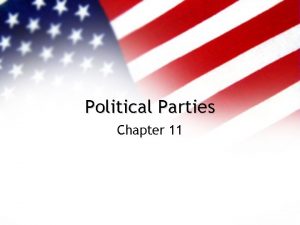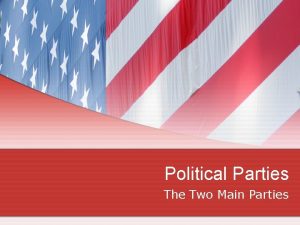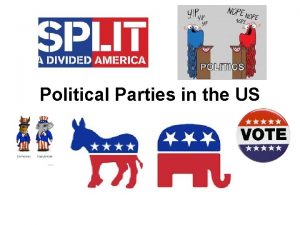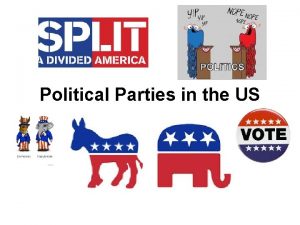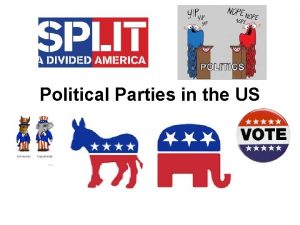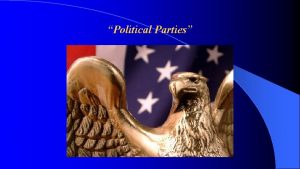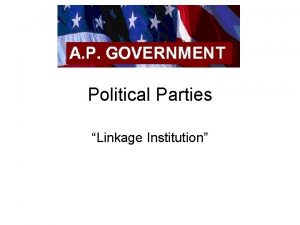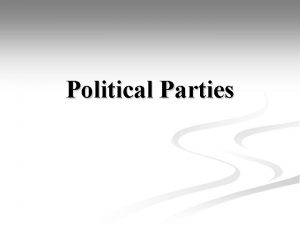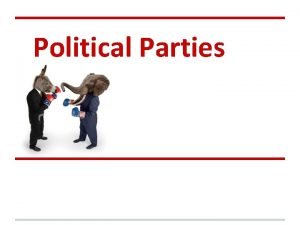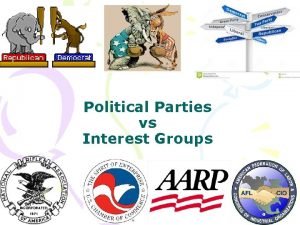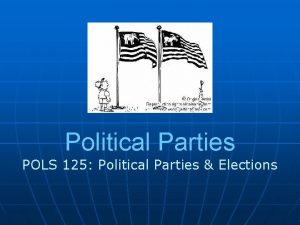Political Parties What are Political Parties A political


















- Slides: 18

“Political Parties”

What are Political Parties? A political party is a group of citizens (voters) with similar views on public issues who work to put their ideas into effect through government action and who band together to elect candidates. Political parties seek to win elections and hold public office.

Purpose of Political Parties pick candidates who agree with their beliefs and try to persuade voters to support their candidates who are running for office. Political parties also: Inform and activate their supporters Act as “bonding agents” to ensure that their candidates perform well in office Utilize partisanship to govern – push the ideas of their party through the government. Act as a watchdog to ensure that all members of the government are having properly and enforcing policies correctly.

Political Spectrum The United States today has a two-party system, which means that we have two main political parties. Generally, parties are often labeled as “liberal” or “conservative, ” depending on their views. Parties fall somewhere on the political spectrum (a range referring to differences in political views). Most people fall somewhere in the middle and are known as “moderates. ” They generally lean toward one side or the other. Left “Liberal” Moderate Right “Conservative”

Today’s Major Parties A basic difference between the major parties is their belief in how much the government should be involved in the lives of Americans. We call this their political ideologies – the way they feel on certain issues.

Crash Course – Political Ideologies

American History – The Two Party System Washington warned against the evils of political parties in his Farewell Address Historians believe that political parties can be traced back to the writing of the Constitution when the Federalists and Anti-Federalists formed. The first full-blown political parties were the Federalist Party (Alexander Hamilton) and the Democratic-Republican Party (Thomas Jefferson). These two men had very different ideas about the type of influence that government should have on the lives of Americans. The origins of today’s major political parties can trace their roots back to these two parties.

American History – The Two Party System

Today’s Major Political Parties Democrats are generally said to be more liberal. They favor more government programs that offer services in housing, education, healthcare, and economics. These programs would be funded through taxes.

Today’s Major Parties Republicans are generally said to be more conservative. Republicans tend to believe that they can help the nation’s economy grow by reducing the amount of taxes that people have to pay. They favor less government regulation of the economy. They are opposed to raising taxes.

Third Parties Although they sometimes challenge the two major parties, a Third Party has never won a Presidential election and has rarely won any other major elections. This is because they are usually very focused on specific issues. There are different types of third parties: Ideological Parties – focused on a core belief system (Communist, Socialist Labor Parties) Single-issues Parties – focused on one public policy matter. (Prohibition Party) Economic Protest Parties – express their discontent with current economic times (Greenback Party, Populist Party) Splinter Parties – a faction of a major political party that breaks away and forms its own (Bull-Moose Progressive Party)

Third Parties Third Parties, however, can affect the outcome of elections and may also influence government policy.

Third Parties rarely win major elections because of the two-party tradition. For example, while the names of Republican and Democratic candidates are automatically placed on the ballot, Third-Party candidates must obtain a large number of signatures to get on the ballot.

Modern Examples of Third Parties The Communist Party supports the rights of the workers and economic equality. The Socialist Party supports government ownership/allocation of resources. The Libertarian Party would like to increase individual freedoms by cutting the size of the U. S. government. According to the Libertarian party, they are “more liberal than Democrats, yet more conservative than Republicans. ” There is also the Green Party, Natural Law Party, the Prohibition Party, and a bunch of others.

Party Platforms To know where a party stands on the major issues, voters can look at the party’s platform.

Party Platforms A platform is a series of statements expressing the party’s principles, beliefs, and positions on issues. Each individual part of a platform is called a plank.

Where do they stand on the Economy, Heath Care, Environment, Education? ? ?

The Issues – Federal Platform (Overall Party Concerns) Plank 1 (Specific Issue) Plank 2 (Specific Issue) Plank 3 (Specific Issue) Plank 4 Unites States Economy Education Health Care Democratic Party Platform Republican Party Platform Wants the federal government to place regulations on businesses to influence economic growth Wants to use tax relief to grow economy and create jobs Wants to raise standards in K-12 Schools and increase financial aid for secondary education Wants to increase access to charter schools, and promote accountability for students and parents Mandated healthcare for all citizens Says mandated healthcare is unconstitutional. Supports Medicare Supports industry of Wants America to
 Insidan region jh
Insidan region jh Political parties
Political parties Political parties pros and cons
Political parties pros and cons Win the white house brainpop
Win the white house brainpop Political parties
Political parties The spoils system made political parties more powerful by
The spoils system made political parties more powerful by Wikimedia
Wikimedia Political parties
Political parties Political parties
Political parties What does the graph indicate?
What does the graph indicate? Chapter 5 section 1 parties and what they do
Chapter 5 section 1 parties and what they do Deprecate in a sentence
Deprecate in a sentence The great gatsby jeopardy
The great gatsby jeopardy Texte incitatif
Texte incitatif Economic protest parties definition
Economic protest parties definition La lettre commerciale
La lettre commerciale Define ideological parties
Define ideological parties Schéma installation fibre optique maison individuelle
Schéma installation fibre optique maison individuelle Accounting information system chapter 1
Accounting information system chapter 1


